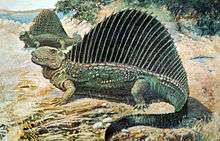Phanerozoic
| Phanerozoic Eon 541–0 million years ago | |
| view • discuss • -4500 — – -4000 — – -3500 — – -3000 — – -2500 — – -2000 — – -1500 — – -1000 — – -500 — – 0 — Scale: Millions of years |
The Phanerozoic Eon[1] (British English Phanærozoic) is the current geologic eon in the geologic time scale, and the one during which abundant animal and plant life has existed. It covers 541 million years to the present,[4] and began with the Cambrian Period when diverse hard-shelled animals first appeared. Its name was derived from the Ancient Greek words φανερός (phanerós) and ζωή (zōḗ), meaning visible life, since it was once believed that life began in the Cambrian, the first period of this eon. The time before the Phanerozoic, called the Precambrian supereon, is now divided into the Hadean, Archaean and Proterozoic eons.
The time span of the Phanerozoic starts with the rapid emergence of a number of animal phyla; the evolution of those phyla into diverse forms; the emergence and development of complex plants; the evolution of fish; the emergence of insects and tetrapods; and the development of modern fauna. Land plant life appeared in the early Phanerozoic eon. During this time span, tectonic forces caused the continents to move and eventually collect into a single landmass known as Pangaea, which then separated into the current continental landmasses.
Proterozoic-Phanerozoic boundary
The Proterozoic-Phanerozoic boundary is at 541 million years ago. In the 19th century, the boundary was set at time of appearance of the first abundant animal (metazoan) fossils but several hundred groups (taxa) of metazoa of the earlier Proterozoic era have been identified since the systematic study of those forms started in the 1950s. Most geologists and paleontologists would probably set the Proterozoic-Phanerozoic boundary either at the classic point where the first trilobites and reef-building animals (archaeocyatha) such as corals and others appear; at the first appearance of a complex feeding burrow called Treptichnus pedum; or at the first appearance of a group of small, generally disarticulated, armored forms termed 'the small shelly fauna'. The three different dividing points are within a few million years of each other.
In the older literature, the term Phanerozoic is generally used as a label for the time period of interest to paleontologists, but that use of the term seems to be falling into disuse in more modern literature.
Eras of the Phanerozoic
The Phanerozoic is divided into three eras: the Paleozoic, Mesozoic, and Cenozoic, which are further subdivided into 12 periods. The Paleozoic features the rise of fish, amphibians and reptiles. The Mesozoic is ruled by the reptiles, and features the evolution of mammals, birds and more famously, dinosaurs. The Cenozoic is the time of the mammals, and more recently, humans.
Paleozoic Era
The Paleozoic is a time in Earth's history when complex life forms evolved, took their first breath of oxygen on dry land, and when the forerunners of all life on Earth began to diversify. There are six periods in the Paleozoic era: Cambrian, Ordovician, Silurian, Devonian, Carboniferous and Permian.[5]
Cambrian Period
The Cambrian is the first period of the Paleozoic Era and starts from 541 to 485 million years ago. The Cambrian sparked a rapid expansion in evolution in an event known as the Cambrian Explosion during which the greatest number of creatures evolved in a single period in the history of Earth. Plants like algae evolved, and the fauna was dominated by armored arthropods, such as trilobites. Almost all marine phyla evolved in this period. During this time, the super-continent Pannotia began to break up, most of which later recombined into the super-continent Gondwana.[6]
Ordovician Period

The Ordovician spans from 485 million years to 440 million years. The Ordovician was a time in Earth's history in which many species still prevalent today evolved, such as primitive fish, cephalopods, and coral. The most common forms of life, however, were trilobites, snails and shellfish. More importantly, the first arthropods crept ashore to colonize Gondwana, a continent empty of animal life. By the end of the Ordovican, Gondwana was at the south pole, and early North America had collided with Europe, closing the Atlantic Ocean. Glaciation of Africa resulted in a major drop in sea level, killing off all life that had established life along coastal Gondwana. Glaciation caused a snowball Earth, leading to the Ordovician-Silurian extinction, during which 60% of marine invertebrates and 25% of families became extinct. This is considered the first mass extinction and the second deadliest in the history of Earth.[7]
Silurian Period
The Silurian spans from 440 million years to 415 million years. The Silurian saw the transition of the Earth from the Snowball Earth. This period saw the mass evolution of fish, as jaw-less fish became more numerous, jawed fish evolved, and the first freshwater fish evolved, though arthropods, such as sea scorpions, remained the apex predators. Fully terrestrial life evolved, which included early arachnids, fungi, and centipedes. Also, the evolution of vascular plants (Cooksonia) allowed plants to gain a foothold on land. These early terrestrial plants are the forerunners of all plant life on land. During this time, there were four continents: Gondwana (Africa, South America, Australia, Antarctica, India), Laurentia (North America with parts of Europe), Baltica (the rest of Europe), and Siberia (Northern Asia). The recent rise in sea levels provided new habitats for many new species.[8]
Devonian Period
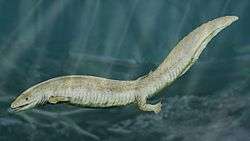
The Devonian spans from 415 million years to 360 million years. Also known as "The Age of the Fish", the Devonian features a huge diversification in fish, including armored fish like Dunkleosteus and lobe-finned fish which eventually evolved into the first tetrapods. On land, plant groups diversified incredibly in an event known as the Devonian Explosion during which the first trees evolved, as well as seeds. This event also allowed the diversification of arthropod life as they took advantage of the new habitat. The first amphibians also evolved, and the fish were now at the top of the food chain. Near the end of the Devonian, 70% of all species became extinct in an event known as the Late Devonian extinction, which is the second mass extinction known to have happened.[9]
Carboniferous Period
The Carboniferous spans from 360 million to 300 million years. During this period, average global temperatures were exceedingly high: the early Carboniferous averaged at about 20 degrees Celsius (but cooled to 10 degrees during the Middle Carboniferous).[10] Tropical swamps dominated the Earth, and the large amounts of trees created much of the carbon that became coal deposits (hence the name Carboniferous). Perhaps the most important evolutionary development of the time was the evolution of amniotic eggs, which allowed amphibians to move farther inland and remain the dominant vertebrates throughout the period. Also, the first reptiles and synapsids evolved in the swamps. Throughout the Carboniferous, there was a cooling pattern, which eventually led to the glaciation of Gondwana as much of it was situated around the south pole, in an event known as the Permo-Carboniferous glaciation or the Carboniferous Rainforest Collapse.[11]
Permian Period
The Permian spans from 300 million to 250 million years and was the last period of the Paleozoic Era. At its beginning, all continents came together to form the super-continent Pangaea, surrounded by one ocean called Panthalassa. The Earth was very dry during this time, with harsh seasons, as the climate of the interior of Pangaea wasn't regulated by large bodies of water. Reptiles and synapsids flourished in the new dry climate. Creatures such as Dimetrodon and Edaphosaurus ruled the new continent. The first conifers evolved, then dominated the terrestrial landscape. Nearing the end of the period, Scutosaurus and gorgonopsids filled the empty desert. Eventually, they disappeared, along with 95% of all life on Earth in an event simply known as "the Great Dying", the world's third mass extinction event.[12][13]
Mesozoic Era
The Mesozoic ranges from 252 million to 66 million years. Also known as "the Age of the dinosaurs", the Mesozoic features the rise of reptiles on their 150 million year conquest of the Earth on the land, in the seas, and in the air. There are three periods in the Mesozoic: Triassic, Jurassic, and Cretaceous.
Triassic Period
The Triassic ranges from 250 million to 200 million years. The Triassic is a desolate transitional time in Earth's history between the Permian Extinction and the lush Jurassic Period. It has three major epochs: Early Triassic, Middle Triassic and Late Triassic.[14]
The Early Triassic lasted between 250 million to 247 million years ago, and was dominated by deserts as Pangaea had not yet broken up, thus the interior was arid. The Earth had just witnessed a massive die-off in which 95% of all life became extinct. The most common life on Earth were Lystrosaurus, labyrinthodonts, and Euparkeria along with many other creatures that managed to survive the Great Dying. Temnospondyli evolved during this time and would be the dominant predator for much of the Triassic.[15]
The Middle Triassic spans from 247 million to 237 million years. The Middle Triassic featured the beginnings of the breakup of Pangaea, and the beginning of the Tethys Sea. The ecosystem had recovered from the devastation of the Great Dying. Phytoplankton, coral, and crustaceans all had recovered, and the reptiles began increasing in size. New aquatic reptiles, such as ichthyosaurs and nothosaurs, evolved. Meanwhile, on land, pine forests flourished, as well as mosquitoes and fruit flies. The first ancient crocodilians evolved, which sparked competition with the large amphibians that had since rule the freshwater world.[16]
The Late Triassic spans from 237 million to 200 million years. Following the bloom of the Middle Triassic, the Late Triassic featured frequent rises of temperature, as well as moderate precipitation (10-20 inches per year). The recent warming led to a boom of reptilian evolution on land as the first true dinosaurs evolved, as well as pterosaurs. The climactic change, however, resulted in a large die-out known as the Triassic-Jurassic extinction event, in which all archosaurs (excluding ancient crocodiles), synapsids, and almost all large amphibians became extinct, as well as 34% of marine life in the fourth mass extinction event. The extinction's cause is debated.[17][18]
Jurassic Period
The Jurassic ranges from 200 million years to 145 million years, and features three major epochs: Early Jurassic, Middle Jurassic, and Late Jurassic.[19]
The Early Jurassic Epoch spans from 200 million years to 175 million years.[19] The climate was much more humid than the Triassic, and as a result, the world was very tropical. In the oceans, plesiosaurs, ichthyosaurs and ammonites dominanted the seas. On land, dinosaurs and other reptiles dominated the land, with species such as Dilophosaurus at the apex. The first true crocodiles evolved, pushing the large amphibians to near extinction. The reptiles rose to rule the world. Meanwhile, the first true mammals evolved, but never exceeded the height of a shrew.[20]
The Middle Jurassic Epoch spans from 175 million to 163 million years.[19] During this epoch, reptiles flourished as huge herds of sauropods, such as Brachiosaurus and Diplodicus, filled the fern prairies of the Middle Jurassic. Many other predators rose as well, such as Allosaurus. Conifer forests made up a large portion of the world's forests. In the oceans, plesiosaurs were quite common, and ichthyosaurs were flourishing. This epoch was the peak of the reptiles.[21]
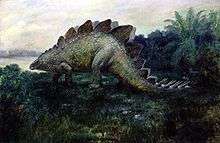
The Late Jurassic Epoch spans from 163 million to 145 million years.[19] The Late Jurassic featured a massive extinction of sauropods and ichthyosaurs due to the separation of Pangaea into Laurasia and Gondwana in an extinction known as the Jurassic-Cretaceous extinction. Sea levels rose, destroying fern prairies and creating shallows. Ichthyosaurs became extinct whereas sauropods, as a whole, did not; in fact, some species, like Titanosaurus, lived until the K-T extinction.[22] The increase in sea-levels opened up the Atlantic sea way which would continue to get larger over time. The divided world would give opportunity for the diversification of new dinosaurs.
Cretaceous Period
The Cretaceous is the longest period in the Mesozoic, spans from 145 million to 66 million years, and is divided into two epochs: Early Cretaceous, and Late Cretaceous.[23]

The Early Cretaceous Epoch spans from 145 million to 100 million years.[23] The Early Cretaceous saw the expansion of seaways, and as a result, the decline and extinction of sauropods (except in South America). Many coastal shallows were created, and that caused ichthyosaurs to die out. Mosasaurs evolved to replace them as apex species of the seas. Some island-hopping dinosaurs, like Eustreptospondylus, evolved to cope with the coastal shallows and small islands of ancient Europe. Other dinosaurs, such as Carcharodontosaurus and Spinosaurus, rose to fill the empty space that the Jurassic-Cretaceous extinction had created. Of the most successful would be the Iguanodon which spread to every continent. Seasons came back into effect and the poles grew seasonally colder. Dinosaurs such as the Leaellynasaura inhabited the polar forests year-round, while many dinosaurs, such as the Muttaburrasaurus, migrated there during summer . Since it was too cold for crocodiles, it was the last stronghold for large amphibians, such as the Koolasuchus. Pterosaurs grew larger as species like Tapejara and Ornithocheirus evolved. More importantly, the first true birds evolved sparking competition between them and the pterosaurs.
The Late Cretaceous Epoch spans from 100 million to 65 million years.[23] The Late Cretaceous featured a cooling trend that would continue into the Cenozoic Era. Eventually, tropical ecology were restricted to the equator and areas beyond the tropic lines featured extreme seasonal changes of weather. Dinosaurs still thrived as new species such as Tyrannosaurus, Ankylosaurus, Triceratops and Hadrosaurs dominated the food web. Pterosaurs, however, were going into a decline as birds took to the skies. The last pterosaur to die off was Quetzalcoatlus. Marsupials evolved within the large conifer forests as scavengers. In the oceans, Mosasaurs ruled the seas to fill the role of the ichthyosaurs, and huge plesiosaurs, such as Elasmosaurus, evolved. Also, the first flowering plants evolved. At the end of the Cretaceous, the Deccan Traps and other volcanic eruptions were poisoning the atmosphere. As this was continued, it is thought that a large meteor smashed into earth, creating the Chicxulub Crater creating the event known as the K-T Extinction, the fifth and most recent mass extinction event, during which 75% of life on Earth became extinct, including all non-avian dinosaurs. Every living thing with a body mass over 10 kilograms became extinct, and the age of the dinosaurs came to an end.[24][25]
Cenozoic Era
The Cenozoic featured the rise of mammals as the dominant class of animals, as the end of the age of the dinosaurs left significant evolutionary vacuums. There are three division of the Cenozoic: Paleogene, Neogene and Quaternary.
Paleogene Period
The Paleogene spans from the extinction of the dinosaurs, some 66 million years ago, to the dawn of the Neogene 23 million years ago. It features three epochs: Paleocene, Eocene and Oligocene.

The Paleogene Epoch began with the K-T extinction event caused by the impact of a metorite in the area of present day Yucatan Peninsula and caused the destruction of 75% of all species on Earth. The Early Paleocene saw the recovery of the Earth from that event. The continents began to take their modern shape, but all continents (and India) were separated from each other. Afro-Eurasia was separated by the Tethys Sea, and the Americas were separated by the strait of Panama, as the Isthmus of Panama had not yet formed. This epoch featured a general warming trend, and jungles eventually reached the poles. The oceans were dominated by sharks as the large reptiles that had once ruled became extinct. Archaic mammals, such as creodonts and early primates that evolved during the Mesozoic filled the world. During this time there were no land creatures over 10 kilograms. Mammals were still quite small.[26]
The Eocene Epoch ranged from 56 million years to 34 million years. In the early Eocene, land animals were small and living in cramped jungles, much like the Paleocene. None had a mass over 10 kilograms.[27] Among them were early primates, whales and horses along with many other early forms of mammals. At the top of the food chains were huge birds, such as Gastornis. It is the only time in recorded history that birds ruled the world (excluding their ancestors, the dinosaurs). The temperature was 30 degrees Celsius with little temperature gradient from pole to pole. In the Middle Eocene Epoch, the circum-Antarctic current between Australia and Antarctica formed which disrupted ocean currents worldwide, resulting in global cooling, and caused the jungles to shrink. This allowed mammals to grow; some such as whales to mammoth proportions, which were, by now, almost fully aquatic. Mammals like Andrewsarchus were now at the top of the food-chain and sharks were replaced by Basilosaurus, whales, as rulers of the seas. The late Eocene Epoch saw the rebirth of seasons, which caused the expansion of savanna-like areas, along with the evolution of grass.[28][29]
The Oligocene Epoch spans from 33 million to 23 million years. The Oligocene featured the expansion of grass which had led to many new species to take advantage, including the first elephants, cats, dogs, marsupials and many other species still prevalent today. Many other species of plants evolved during this epoch also, such as the evergreen trees. The long term cooling continued and seasonal rains patterns established. Mammals continued to grow larger. Paraceratherium, the largest land mammal to ever live evolved during this epoch, along with many other perissodactyls in an event known as the Eocene–Oligocene extinction event (Grand Coupure).[30]
Neogene Period

The Neogene spans from 23 million to 3 million years, and is the shortest geological period in the Phanerozoic Eon. It features two epochs: Miocene and Pliocene.[31]
The Miocene Epoch spans from 23 to 5 million years and is a period during which grass spread further, effectively dominating a large portion of the world, and diminished forests in the process. Kelp forests evolved, leading to new species, as the likes of sea otters took advantage of the new habitat. During this time, perissodactyls thrived, and evolved into many different varieties. Alongside those were the apes, which evolved into a staggering 30 species. Overall, arid and mountainous land dominated most of the world, as did grazers. The Tethys Sea finally closed with the creation of the Arabian Peninsula and in its wake left the Black, Red, Mediterranean and Caspian Seas. This only increased aridity. Many new plants evolved, and 95% of modern seed plants evolved in the mid-Miocene.[32]
The Pliocene Epoch ranges from 5 to 3 million years. The Pliocene featured dramatic climactic changes, which ultimately led to modern species and plants. The most dramatic are the formation of Panama Ishtmus, and the accumulation of ice at the poles, leading to a massive die-off, India and Asia collided forming the Himalayas, the Rockies and Appalachian mountain ranges were formed, and the Mediterranean Sea dried up for the next several million years. Along with these major geological events, Australopithecus evolved in Africa, beginning the human branch. Animals took advantage of the Isthmus of Panama, to migrate between North and South America, wreaking havoc on the local ecology. Climactic changes brought savannas that continue to spread across the world, Indian monsoons, deserts in East Asia, and the beginning of the Sahara desert. The Earth's continents and seas moved into their present shapes, and the world land masses have not changed much since.[33][34]
Quaternary Period
The Quaternary ranges from 3 million years to the present day, and features modern animals and dramatic climate changes. It consists of two epochs: Pleistocene and Holocene.
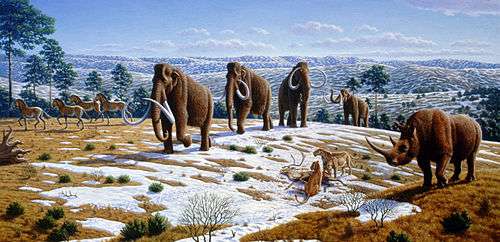
The Pleistocene Epoch lasted from 3 million to 12,000 years. This epoch featured the ice ages that resulted from the cooling effect that started in the Mid-Eocene Epoch of the Paleogene Period. As the ice progressively migrated towards the equator, the area outside of the tropic lines featured intense winters yet mild summers. Meanwhile, Africa experienced intense droughts, which resulted in the creation of the Sahara, Namib, and Kalahari deserts. To cope, many animals, including mammoths, giant ground sloths, dire wolves, evolved and most famously Homo sapiens. The worst droughts of Africa ended 100,000 years ago, and marked the expansion of primitive man. As the Pleistocene Epoch drew to a close, one of the largest die-outs caused many mega-fauna to die off, including the last hominid species (excluding Homo sapiens). All continents were affected, but Africa less so.[35]
The Holocene Epoch ranges from 12,000 years to present day. All recorded history and "the history of the world" lie within the boundaries of the Holocene epoch.[36] Human activity, however, is being blamed for a die-out that has been progressing since 10,000 B.C.E. commonly referred to as "the Sixth Extinction" at an extinction rate of 140,000 species per year.[37]
Biodiversity
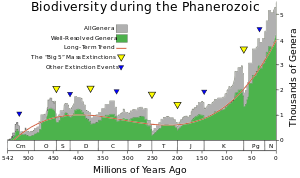
It has been demonstrated that changes in biodiversity through the Phanerozoic correlate much better with the hyperbolic model (widely used in demography and macrosociology) than with exponential and logistic models (traditionally used in population biology and extensively applied to fossil biodiversity as well). The latter models imply that changes in diversity are guided by a first-order positive feedback (more ancestors, more descendants) or a negative feedback that arises from resource limitation, or both. The hyperbolic model implies a second-order positive feedback. The hyperbolic pattern of the human population growth arises from a second-order positive feedback, caused by the interaction of the population size and the rate of technological growth.[38] The character of biodiversity growth in the Phanerozoic Eon can be similarly accounted for by a feedback between the diversity and community structure complexity. It is suggested that the similarity between the curves of biodiversity and human population probably comes from the fact that both are derived from the superposition on the hyperbolic trend of cyclical and random dynamics.[38]
See also
Notes
- ↑ There are several ways of pronouncing Phanerozoic, including /ˌfænərəˈzoʊɪk, ˌfænrə-, -roʊ-/.[2][3]
- ↑ "Phanerozoic". Oxford Dictionaries. Oxford University Press. Retrieved 2016-01-20.
- ↑ "Phanerozoic". Merriam-Webster Dictionary.
- ↑ Cohen, K.M.; Finney, S.C.; Gibbard, P.L.; Fan, J.-X. (2013). "International Chronostratigraphic Chart v 2015/01" (PDF). Episodes 36: 199-204. International Commission on Stratigraphy. Retrieved 2015-11-26.
- ↑ University of California. "Paleozoic". University of California.
- ↑ University of California. "Cambrian". University of California.
- ↑ University of California. "Ordovician". University of California.
- ↑ University of California. "Silurian". University of California.
- ↑ University of California. "Devonian". University of California.
- ↑ Monte Hieb. "Carboniferous Era". unknown.
- ↑ University of California. "Carboniferous". University of California.
- ↑ Natural History Museum. "The Great Dying". Natural History Museum.
- ↑ University of California. "Permian Era". University of California.
- ↑ Alan Logan. "Triassic". University of New Brunswick.
- ↑ Alan Kazlev. "Early Triassic". unknown.
- ↑ Rubidge. "Middle Triassic". unknown.
- ↑ Graham Ryder; David Fastovsky & Stefan Gartner. "Late Triassic Extinction". Geological Society of America.
- ↑ Enchanted Learning. "Late Triassic life". Enchanted Learning.
- 1 2 3 4 Carol Marie Tang. "Jurassic Era". California Academy of Sciences.
- ↑ Alan Kazlev. "Early Jurassic". unknown.
- ↑ Enchanted Learning. "Middle Jurassic". Enchanted Learning.
- ↑ Bob Strauss. "Cretaceous sauropods". author.
- 1 2 3 Carl Fred Koch. "Cretaceous". Old Dominion University.
- ↑ University of California. "Cretaceous". University of California.
- ↑ Elizabeth Howell. "K-T Extinction event". Universe Today.
- ↑ Encyclopedia Britannica. "Paleocene". Encyclopedia Britannica.
- ↑ University of California. "Eocene Epoch". University of California.
- ↑ University of California. "Eocene Climate". University of California.
- ↑ National Geographic Society. "Eocene". National Geographic.
- ↑ University of California. "Oligocene". University of California.
- ↑ Encyclopedia Britannica. "Neogene". Encyclopedia Britannica.
- ↑ University of California. "Miocene". University of California.
- ↑ University of California. "Pliocene". University of California.
- ↑ Jonathan Adams. "Pliocene climate". Oak Ridge National Library.
- ↑ University of California. "Pleistocene". University of California.
- ↑ University of California. "Holocene". University of California.
- ↑ International Union for Conservation of Nature. "Sixth Extinction". International Union for Conservation of Nature.
- 1 2 See, e. g., Markov, A.; Korotayev, A. (2008). "Hyperbolic growth of marine and continental biodiversity through the Phanerozoic and community evolution". Zhurnal Obshchei Biologii (Journal of General Biology). 69 (3): 175–194.
References
- Markov, Alexander V.; Korotayev, Andrey V. (2007). "Phanerozoic marine biodiversity follows a hyperbolic trend". Palaeoworld. 16 (4): 311–318. doi:10.1016/j.palwor.2007.01.002.
- Miller, K. G.; Kominz, M. A.; Browning, J. V.; Wright, J. D.; Mountain, G. S.; Katz, M. E.; Sugarman, P. J.; Cramer, B. S.; Christie-Blick, N; Pekar, S. F.; et al. (2005). "The Phanerozoic record of global sea-level change". Science. 310 (5752): 1293–1298. Bibcode:2005Sci...310.1293M. doi:10.1126/science.1116412. PMID 16311326.
External links
-
 Media related to Phanerozoic at Wikimedia Commons
Media related to Phanerozoic at Wikimedia Commons
| Preceded by Proterozoic Eon | Phanerozoic Eon | |||||||||||
|---|---|---|---|---|---|---|---|---|---|---|---|---|
| Paleozoic Era | Mesozoic Era | Cenozoic Era | ||||||||||
| Cambrian | Ordovician | Silurian | Devonian | Carboniferous | Permian | Triassic | Jurassic | Cretaceous | Paleogene | Neogene | 4ry | |

